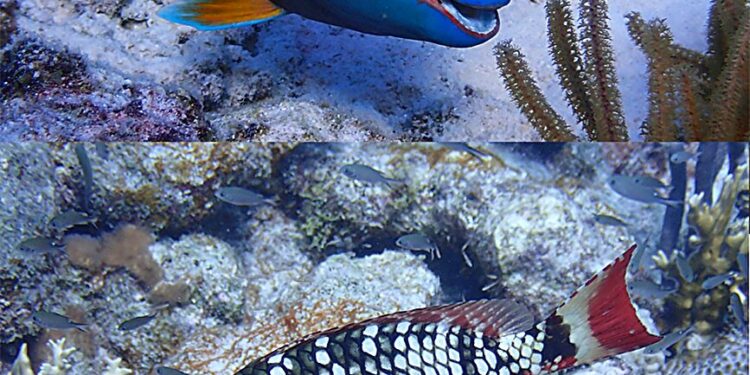Top: A male parrotfish. Bottom: A female. Credit: Joshua Manning/CU Boulder
Neighbors can be annoying. They can be noisy or invade your space. But is it worth fighting with them? Parrotfish choose not to.
In a new study published August 28 in the journal EcologyA CU Boulder researcher and his collaborator have revealed that the Spotlight parrotfish, a brightly colored species found in shallow waters off Florida and in the Caribbean Sea, behaves more tolerantly toward neighboring parrotfish but more aggressively toward strangers.
The researchers spent days underwater observing the colorful fish, providing key insights into a species that plays a vital role in maintaining healthy coral reefs and contributing to the Caribbean’s white-sand beaches.
“Parrotfish play an important role in the coral reef ecosystem and the ecological functions they provide,” said Joshua Manning, first author of the study and a postdoctoral researcher in the Department of Ecology and Evolutionary Biology. “Understanding their behavior will help us assess whether and how they can mitigate the effects of climate change on coral reefs.”
Dear enemy
The Spotlight Parrotfish is one of the largest species of Caribbean reef parrotfish, measuring approximately 1.5 feet long. It has strong, beak-like teeth that allow it to spend up to 90 percent of the day munching on microscopic organisms that thrive on and in the calcium carbonate structures created by corals. By removing coral skeletons, the fish creates space for new corals to grow and produce white sand as a digestive waste.
As highly territorial animals, male parrotfish defend territories as large as two tennis courts, where they feed and mate with a small group of females. But not all parrotfish have territories. Some “floaters,” as Manning calls them, constantly scan the reefs, ready to claim any space that becomes available.
As an experienced diver, Manning spent more than 400 hours underwater during his doctoral studies trying to understand how parrotfish behave and interact with each other. He noticed that these fish might be more intelligent than many people thought.
He tracked 10 parrotfish off the Caribbean island of Bonaire. He noticed that whenever a parrotfish passed by an occupied territory, the territory holders puffed up, spread their fins, and aggressively chased the parrotfish.
But when parrotfish from neighboring territories swam close to territorial boundaries, the territory holders were much less aggressive. When parrotfish did behave aggressively toward their neighbors, it was most often because they had strayed too far from another parrotfish’s territory while chasing another parrotfish, leading to retaliation.
Scientists have observed this “dear enemy” effect—when territory owners are less aggressive toward neighbors than toward strangers—in squirrels, sparrows, frogs, and other animals. Manning and her collaborator, Sophie McCoy, a marine biologist at the University of North Carolina at Chapel Hill, first described the phenomenon in parrotfish.
Manning said parrotfish may be more aggressive toward floaters because they are more likely to try to oust territory holders and take over their territory. Although territorial males have a better chance of mating, their constant patrolling and defense efforts take a toll on their fitness. As a result, they must focus their energy on fighting off the most significant threats.
A male parrotfish chases another. Credit: Joshua Manning/CU Boulder
To the team’s surprise, the floating fish seemed to recognize territorial boundaries. Manning noticed that floating fish often swam across reefs, using the buffer zones between established territories to avoid aggression.
“These fish may be smarter than we think. They appear to recognize their neighbors, find the boundaries of their territories, and have the ability to learn and use information,” Manning said.
Coral moor
Due to climate change, coral reefs are rapidly declining. Between 2023 and mid-May 2024, scientists have confirmed massive coral bleaching in at least 62 countries and territories around the world. Coral bleaching occurs when corals expel algae living in their tissues under stressful conditions, such as high ocean temperatures, causing them to turn completely white.
Parrotfish depend on coral reefs for food and shelter. Coral loss due to ocean acidification and warming can have significant impacts on their habitat and populations. At the same time, parrotfish can speed up reef recovery after bleaching events by creating bare space for new coral larvae to settle and grow.
“Reefs are a vital source of food for us and are home to immense biodiversity, including species with important medical potential. By studying how parrotfish use space and how their grazing influences coral recruitment patterns, we can better understand how reefs can recover from disturbances and adapt to climate change,” Manning said.
More information:
Joshua C. Manning et al., Effects of the dear enemy in the red-fired parrotfish, Sparisoma viride, Ecology (2024). DOI: 10.1002/ecy.4407
Provided by University of Colorado Boulder
Quote: Guardians of the Reef: How Parrotfish Promote Coral Health (2024, September 5) retrieved September 5, 2024 from
This document is subject to copyright. Apart from any fair dealing for the purpose of private study or research, no part may be reproduced without written permission. The content is provided for informational purposes only.



